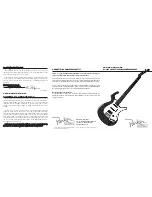
Tuning with the Hex
Key
Note: On a guitar with EverTune, ALL the tuning is done with the
EverTune hex key at the bridge (Fig. 2). The tuning pegs at the
headstock are only used to put each saddle into Zone 2, and to
adjust each saddle’s position for optimal bend sensitivity.
����������������
������������
������������
���
���
�
����
������������������������������������
�����
To tune a string, put the saddle in Zone 2, as covered in Step 1,
and then use the EverTune hex key to adjust the tension of the
saddle. Insert the EverTune hex key into the tuning hole (Fig.
3) and then turn it clockwise to increase the pitch and counter-
clockwise to decrease the pitch. Always remove the key before
checking the tune.
Every one half turn of the hex key is about 15 cents adjustment
on a tuner (fig. 4). [Please check out our Tuning page from
evertune.com/setupfaq for more info].
Fig. 3
Fig. 4
Fig. 2 EverTune Tuning
STEP 2
STEP 3
Bending
Once the saddle is in zone 2, as covered in Step 1, and the
string is in tune, as covered in Step 2, it is time to set the bend
sensitivity. Tighten the tuning peg at the headstock while
plucking the string until the note goes sharp. Then loosen the
tuning peg until the note drops right back into tune (Fig. 5).
The point at which the note drops right back into tune is the
transition point between Zone 2 and outside of Zone 2.
At this point the string bends and tremolos like a conventional
guitar except that the note will always stay in tune after the
bend. This point is maximum bend sensitivity.
Loosen the tuning peg about an eighth of a turn from the
boundary where the note goes sharp and we come to a point
where bends still happen fast and the intonation and tuning
are preserved even with heavy picking intensity and hard
finger pressure (Fig. 6). This is great for people who detune their
strings, or vary their picking intensity and finger pressure, and
want to still be perfectly in tune and intonated.
�������
������
�����������
������
����������
�����
Fig. 5 Maximum Bend Sensitivity
NOTE: The EverTune hex key is a standard 2.5mm hex key available
at all hardware stores.






















